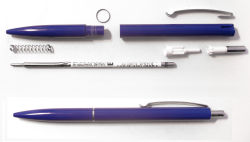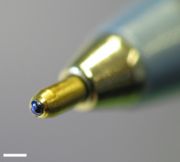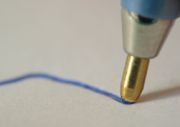Ballpoint pen

A ballpoint pen (also eponymously known in British English as a biro and pronounced bye-row in Britain but sometimes bee-row elsewhere, depending on location), is a modern writing instrument. A ballpoint pen has an internal chamber filled with a viscous ink that is dispensed at the tip during use by the rolling action of a small metal sphere (0.7 mm to 1 mm in diameter); the ink dries almost immediately after contact with paper. Inexpensive, reliable and maintenance-free, the ballpoint has almost completely replaced the fountain pen.History


The manufacture of economical, reliable ballpoint pens resulted from a combination of experimentation, modern chemistry and the precision manufacturing capabilities of 20th century technology. Many patents worldwide are testaments to failed attempts to make these pens commercially viable and widely available. It has even been argued that a design by Galileo Galilei (during the 17th century), was that of a ballpoint pen.
The first patent on a ballpoint pen was issued on 30 October, 1888, to John J Loud. The pen had a rotating small steel ball, held in place by a socket. The pen proved to be too coarse for letter writing, but it could be used to mark rough surfaces, especially leather, but it was not commercially exploited. Slavoljub Eduard Penkala had invented a solid-ink fountain pen in 1907, a German inventor called Baum took out a patent in 1910, and yet another ballpoint pen device was patented by Van Vechten Riesburg in 1916. The ink was placed in a thin tube, whose end was blocked by a tiny ball, held so that it could not slip into the tube or fall out of the pen. The ink clung to the ball, which spun as the pen was drawn across the paper. These proto-ballpoints did not deliver the ink evenly. If the ball socket was too tight, the ink did not reach the paper. If it was too loose, ink flowed past the tip, leaking or making smears. Many inventors applied their minds and skills to remedying these faults, but without commercial success.
Ladislas
was frustrated by the amount of time that he wasted in filling up fountain pens
and cleaning up smudged pages, and the sharp tip of his fountain pen often tore
his pages. Biro had noticed that the type of ink used in newspaper printing
dried quickly, leaving the paper dry and smudge free. He decided to create a pen
using the same type of ink. Since, when tried, this viscous ink would not flow
into a regular fountain pen with the help of his brother George, a chemist began
to work on designing new types of pens. He fitted this pen with a tiny ball in
its tip that was free to turn in a socket. As the pen moved along the paper, the
ball rotated, picking up ink from the ink cartridge and leaving it on the paper.
He filed a British patent on 15 June, 1938.
Earlier pens leaked or clogged due to improper viscosity of the ink and depended on gravity to deliver the ink to the ball. Depending on gravity caused difficulties with the flow and required that the pen be held nearly vertically. The Biro pen both pressurized the ink column and used capillary action for ink delivery, solving the flow problems.
In 1940 the Biro brothers and a friend, Juan Jorge Meyne, moved to Argentina fleeing nazi Germany and on June 10, filed another patent, and formed Biro Pens of Argentina. The pen was sold in Argentina under the Birome brand (acronym of Biro and Meyne), which is how ballpoint pens are still known in that country. Laszlo was known in Argentina as Ladislao. This new design was licensed by the British, who produced ball point pens for RAF aircrew, who found they worked much better than fountain pens at high altitude.
Eversharp, a maker of mechanical pencils teamed up with Eberhard-Faber in May 1945 to license the design for sales in the United States. At about the same time a U.S. businessman saw a Biro pen in a store in Buenos Aires. He purchased several samples and returned to the U.S. to found the Reynolds International Pen Company, producing the Biro design without license as the Reynolds Rocket. He managed to beat Eversharp to market in late 1945; the first ballpoint pens went on sale at Gimbel's department store in New York City on October 29, 1945 for US$12.50 each (about USD$130 of today's money). This pen was widely known as the rocket in the U.S. into the late 1950s.
Similar pens went on sale before the end of the year in England, and by the next year in most of Europe. Cheap disposable instruments were produced by the BIC Corporation with "Bic" as the tradename; as with 'Hoover' and 'Xerox', the tradename has subsequently passed into general use. With BIC's expanding product range, the original Bic pen design is now termed the Bic Cristal.
Since 1990, Biro's birthday (the 29th of September) is Inventor's Day in Argentina.
Description

There are two basic types of ball point pen: disposable and refillable.
Disposable pens are chiefly made of plastic throughout and discarded when the ink is consumed; refillable pens are metal or plastic and tend to be higher in quality and price. The refill tends to replace the entire internal ink reservoir and ball point unit rather than actually refilling it with ink.
The simplest types of ball point pens have a cap to cover the tip when the pen is not in use, while others have a mechanism for retracting the tip. This is usually controlled by a button at the top and powered by a spring within the pen apparatus, but other possibilities include a pair of buttons, a screw, or a slide.
- Rollerball pens, which combine the ballpoint design with the use of liquid ink and flow systems from fountain pens;
- "Space Pens", developed by Fisher in the United States, which combine a more viscous than normal ballpoint pen ink with a gas pressurized piston which forces the ink toward the point. This design allows the pen to write even upside down or in zero gravity environments.
Ballpoint pens in everyday life
Ballpoint pens are ubiquitous in modern culture. While other forms of pen are available, ballpoint pens are certainly the most common and almost every household is likely to have several. The fact that they are so cheaply available (costing from just a few cents/pence to produce) and so convenient to use means they are often to be found on desks and also in pockets, handbags, purses, bags and in cars—almost anywhere where one could conceivably need to use a pen. Ballpoint pens are often provided free by businesses as a form of advertising printed with a company's name, a ballpoint pen is a relatively low cost advertisement that is highly effective (customers will use, and therefore see, a pen on a daily basis). Businesses and charities may also include ballpoint pens in direct mail mailings in order to increase a customer's interest in the mailing.
In recent years, the ballpoint pen has become a popular art medium, as demonstrated by such websites as biro-art.com. Many people also create art on themselves with the pens; this is sometimes known as a ballpoint tattoo. Due to this, and to its wide-spread use by schoolchildren, all ballpoint ink formulas are non-toxic, and the manufacturing and content of the ink is regulated in most countries.
Grip and feel
Ballpoint pens have three characteristics that distinguish them from rollerball systems. First, the ink flow increases with pressure. A rollerball will typically lay down its line without pressure.
Second, they write with the greatest ink flow when perpendicular to the paper, but as the angle is increased the line width gradually decreases; at some angle, when the edge of the ball socket brushes against the surface of the paper, the line width is reduced to zero and the pen ceases to write. (By way of contrast, a rollerball pen has a thin line when perpendicular to the paper, but the line width increases suddenly as the angle is increased and a blob forms between the tip of the ball and the edge of the socket.)
Third, a ballpoint pen's ink is typically not as bright on paper as its liquid or gel ink counterparts.
These characteristics have consequences for the grip with which the pen is held. First, one tends to bear down on a ballpoint to get a stronger line, and this increases tension in the hand. (One way of getting a stronger line, comparable in intensity to a rollerball line, is to use a broad line ballpoint, with a 1.2mm diameter, or greater, ball size. Most ballpoints have a thin or medium ball.)
Second, one has to hold the pen sufficiently vertically for it to roll across the paper and not to scratch. Most people nowadays are so accustomed to writing nearly perpendicularly that they do not realize that there are other ways to hold a pen.
There are two kinds of pens that can write at greater angles than ballpoint pens: fountain pens and felt-tipped pens. Both of these types of pen also write with less pressure and therefore with less tension in the hand.
Limits of ballpoint pens
- Ballpoint pens cannot write upside down. see How Ballpoint Pens Work
- Cannot write on plastics and shiny surfaces.
- Cannot write on wet or oily surfaces.
Repairing a ballpoint pen
If you have a ballpoint pen which has stopped working (although there is still a quantity of ink remaining), there are a number of techniques available to restore their functionality:
- Scribble circles on cardboard found covering notepads. Normal 80gsm paper doesn't seem to restore ink flow as quickly.
- Simply draw a few circles on a glass surface (the closest window works well) [6]
- Heat the ball point for a few seconds over a small flame (eg. cig. lighter) [7][8]
- Insert inside the opening of your ink cartridge a piece of mechanical pencil graphite(best to be 0.7) [9]
External links
- Biro Art - Doodles with a ball point pen.
- A history of the ballpoint pen.
- Dennis Carlisle, Ball point pen artist.
- Information about pens of various types; pen help for beginners.
- Eric Bostrom's gallery (has come up with some blending techniques, as well)
- Did Biros really revolutionise writing? - BBC News - October 24, 2006
